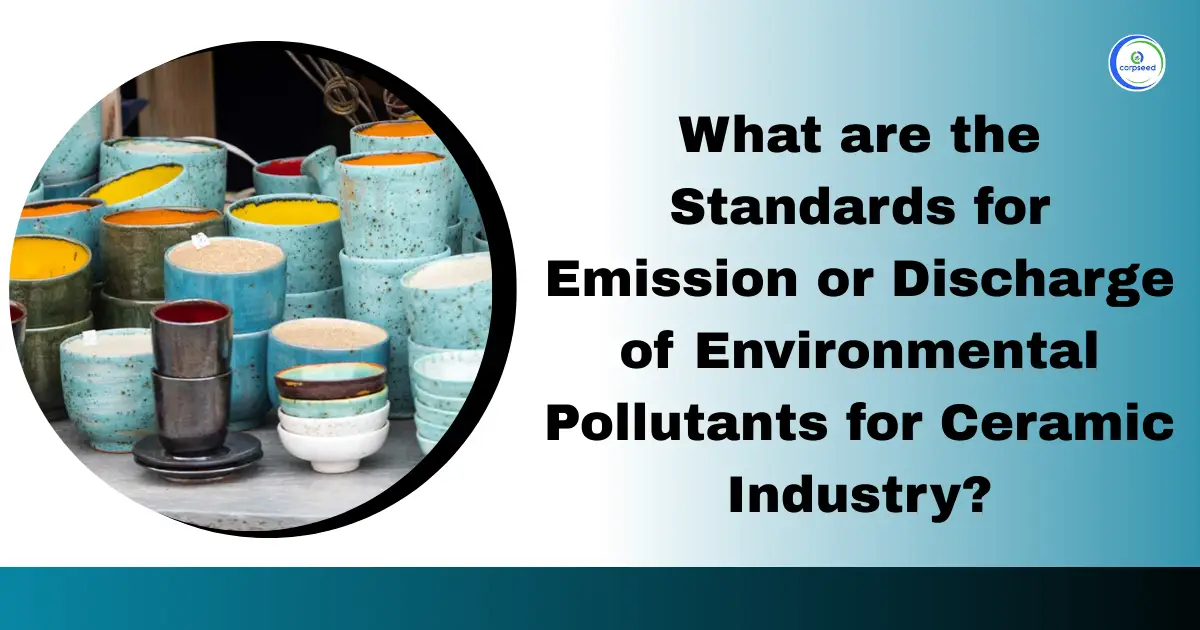The ceramic industry produces tiles, sanitary ware, and other useful products. But it also causes pollution, which can harm the air, water, and soil. To regulate this, the government has clear regulations for the industry. These regulations help protect the environment and public health. The Environment (Protection) Rules, 1986, play a major role in setting these standards. They list limits on pollutants that factories can release into the air and water. This includes smoke, dust, chemicals, and wastewater. Every ceramic unit must comply with these limits to operate legally and safely. They must regularly check their pollution levels and take steps to reduce harmful waste. These actions help keep the surrounding area clean while helping the industry grow in a safe and responsible way.
Table of Contents
--------------Blog Contact Form-------------
Overview of the Environment (Protection) Rules, 1986
The Environment (Protection) Rules, 1986, were enacted under the Environment (Protection) Act, 1986. These regulations empower the central government to set limits on pollutants released by industries, including the ceramics industry. The main goal is to protect the environment and human health from harmful industrial emissions. For the ceramic industry, specific standards are set for various pollutants. These include particulate matter (PM), fluoride, sulphur dioxide (SO2), chloride, and other air pollutants. The industry must also manage wastewater discharge, solid waste, and dust emissions during production. These limits help reduce air and water pollution. The Central Pollution Control Board (CPCB) and the State Pollution Control Boards (SPCB) play a key role in enforcing these standards.
Industries should take measures to control emissions and meet environmental compliance requirements. They are also expected to conduct an Environmental Impact Assessment (EIA) before setting up new plants or expanding existing plants. By following the Environment (Protection) Rules, 1986, the ceramic industry can operate in a clean, safe and sustainable manner. These regulations support better environmental management and reduce the harmful impact of industrial activities. Regular inspections and monitoring ensure that the industry adheres to the set standards.
Emission Standards for Kilns in the Ceramic Industry
Different types of kilns are used in the ceramic industry. Each type has a different emission limit:
| S.No. | Type of Kiln | Particulate Matter (mg/Nm³) | Fluoride (mg/Nm³) | Chloride (mg/Nm³) | Sulphur Dioxide |
| 1 | Tunnel, Top Hat, Chamber | 150 | 10 | 100 | Based on stack height |
| 2 | Down-draft | 1200 | 10 | 100 | Based on stack height |
| 3 | Shuttle | 150 | 10 | 100 | Based on stack height |
| 4 | Vertical Shaft Kiln | 250 | 10 | - | Based on stack height |
| 5 | Tank Furnace | 150 | 10 | - | Based on stack height |
Note: Sulphur dioxide emissions are not given in mg/nm3 but are managed through stack height based on coal consumption. This helps the gases to disperse and reduces their impact on local air quality.
Emission Standards for the Handling and Processing of Raw Materials
Dust and fine particles are generated during handling and processing of raw materials. Using proper equipment such as dust collectors and closed conveyors can help industries reduce dust emissions and meet CPCB and SPCB standards. These activities must control particulate matter emissions:
- Dry raw material handling and processing: Maximum 150 mg/nm3.
- Basic raw material handling and other sources: Standards are not fixed but industries have to implement all practical pollution control measures.
Emission Standards for Automatic Spray Units
Automatic spray units are used to coat ceramics with glazes and paints. This includes dryers and mechanical finishing units. The manufacture of lime or Plaster of Paris, which is often part of ceramic units, also requires pollution control. In all cases, pollution control devices must be used to meet environmental compliance. Emission standards for dryers are as follows:
- Fuel-fired dryers: 150 mg/nm3 of particulate matter.
- Heat recovery dryers and mechanical finishing operations: There is no fixed limit, but industries should take all preventive actions to control emissions.
Stack Height Requirements
Stack height is critical to controlling air pollution. It helps properly disperse pollutants like sulphur dioxide. The required stack height depends on two main factors: the type of kiln and the fuel consumption.
Kiln Capacity
| S.No. | Industry Capacity | Parameter | Standards |
| 1 | Up to 5 T/day | Stack Height | Hood with a stack of 30 meters (from ground level, including kiln height) |
| 2 | Above 5 T/day | Stack Height | H = 14(Q)0.3 (Q = SO₂ emission in kg/hr; H = Stack height in meters) |
| 3 | >5 T/day and up to 40 T/day | Particulate Matter | 500 mg/NM³ |
| 4 | Above 40 T/day | Particulate Matter | 150 mg/NM³ |
Stack Height Limits for Kilns with Various Capacities of Coal Consumption
| S.No. | Coal Consumed Per Day (MT) | Minimum Stack Height (m) |
| 1 | Less than 8.5 | 9 |
| 2 | 8.5 to 21 | 12 |
| 3 | 21 to 42 | 15 |
| 4 | 42 to 64 | 18 |
| 5 | 64 to 104 | 21 |
| 6 | 104 to 105 | 24 |
| 7 | 105 to 126 | 27 |
| 8 | More than 126 | 30 or as per formula |
Note: These values ensure proper dispersion of sulphur dioxide. This is a key factor in meeting CPCB and SPCB guidelines.
Monitoring and Legal Compliance
Every ceramic unit should regularly monitor its emissions and share the results with both the State Pollution Control Board (SPCB) and the Central Pollution Control Board (CPCB). This regular monitoring ensures that the unit complies with all environmental regulations and standards. Environmental compliance also includes the preparation of Environmental Impact Assessment (EIA) reports. This report is important because it identifies potential pollution risks and recommends control measures before any new projects begin. An EIA is required before establishing a new ceramics plant or expanding an existing one. The CPCB and SPCB review these reports carefully and grant permission only if all norms are met. If a ceramic unit fails to meet the required emissions standards, it may face serious action such as fines, suspension or permanent closure. These measures help to reduce pollution and protect the environment while ensuring that the ceramics industry develops responsibly and sustainably.
Conclusion
The ceramic industry must comply with strict pollution control regulations to protect the environment and public health. The Environment (Protection) Rules, 1986, set clear limits on emissions and discharges. The CPCB and SPCB ensure that these standards are followed. Ceramic units must control particulate matter, fluoride, and sulphur dioxide through proper equipment and stack height. Regular monitoring, reporting and environmental compliance are mandatory. An Environmental Impact Assessment (EIA) is required before any unit can be started or expanded. These steps help reduce harmful emissions, protect air and water, and support sustainable development. If the industry does not comply with the norms, it faces legal penalties. By meeting these standards, the ceramics industry can balance growth with environmental care. Responsible practices and pollution control help the sector develop in a clean and safe manner. This ensures long-term benefits for both the industry and the environment.
This portion of the site is for informational purposes only. The content is not legal advice. The statements and opinions are the expression of author, not corpseed, and have not been evaluated by corpseed for accuracy, completeness, or changes in the law.
BOOK A FREE CONSULTATION
Get help from an experienced legal adviser. Schedule your consultation at a time that works for you and it's absolutely FREE.







.webp)

